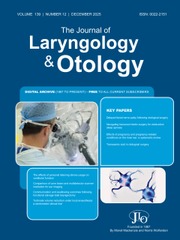Article contents
The point-touch technique for botulinum toxin injection in adductor spasmodic dysphonia: quality of life assessment
Published online by Cambridge University Press: 27 April 2011
Abstract
Botulinum toxin injection under electromyographic guidance is the ‘gold standard’ for adductor spasmodic dysphonia treatment. The point-touch technique, an alternative injection method which relies on anatomical landmarks, is cheaper, quicker and more accessible, but has not yet gained widespread acceptance due to concerns about patient satisfaction.
To assess swallowing and voice-related quality of life following point-touch botulinum toxin injection in adductor spasmodic dysphonia patients.
Stanford University Voice and Swallowing Center.
Prospective case series (evidence level four).
Consecutive adductor spasmodic dysphonia patients with a stable botulinum toxin dose–response relationship were recruited prospectively. The Eating Assessment Tool and Voice-Related Quality of Life questionnaires were completed pre-treatment and at 10 and 30 per cent completion of the injection cycle, respectively.
Thirty-seven patients completed follow up. The mean total botulinum toxin dose was 0.88 units. Pre-treatment Voice-Related Quality of Life questionnaire results reflected the burden of disease. Post-treatment Eating Assessment Tool and Voice-Related Quality of Life questionnaire results were collected at 2.53 and 7.84 weeks, respectively; the former showed an increase in dysphagia, albeit statistically insignificant, while the latter showed significantly improved scores (both domain and total).
The point-touch technique is a viable alternative for botulinum toxin injection in the treatment of adductor spasmodic dysphonia.
- Type
- Main Articles
- Information
- Copyright
- Copyright © JLO (1984) Limited 2011
Footnotes
Presented at the Canadian Society of Otolaryngology – Head and Neck Surgery Meeting, 23–26 May 2010, Niagara Falls, Ontario, Canada
References
- 10
- Cited by


